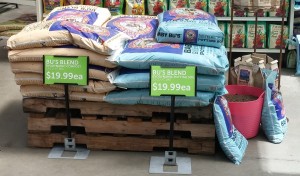Last week I was having lunch with my mom at our favorite nearby nursery/café. After failing to resist the grilled cheese sandwich (3 cheeses! And buttery panini bread!), we walked off lunch in the garden supply part of the nursery. Normally I’m on my best behavior when I’m shopping with my mom (i.e. I don’t take photos of things I’m going to take to task on the blog). But like the 3-cheese grilled sandwich I was unable to resist the bags of biodynamic compost.

Long-time readers of the blog may remember my earlier column and post on biodynamics. Since I wrote the original column over 10 years ago I’ve watched biodynamic marketing move from boutique wines to coffee, tea, tomato sauce…and now to garden products. Really expensive garden products, as in $19.99 for one cubic foot of compost.

What makes this bag of compost worth $19.99? One has to assume it’s the biodynamic preparations used to treat the compost. They’re referred to in the label under “concentrations of yarrow” and so on. Do these preparations make a difference? The label suggests it might be to restore the soil’s vitality. Is there validity to this claim?

In 2013 I published a review of the scientific literature on biodynamics, specifically looking at whether biodynamic preparations have a measurable impact on anything they’re applied to. In a nutshell, the answer is no. (Though this article is behind a paywall, I can send a pdf to you by email if you’d like to read it.)
Don’t let packaging and magical words sway you. Compost made with local materials like bark or agricultural wastes and certified by the US Composting Council is reasonably priced and sustainable.
I’d really love to read that review, if possible!
On its way!
Please also send me the review.
On its way!
I am interested in the rest of the story. Might I have a copy of the PDF?
On its way!
I would like to read it as well. Thanks
It’s on the way!
What effect does the neem oil seed have on the organisms in the compost? I would also like to read the review.
Though neem seed oil has pesticidal qualities, I imagine it is broken down pretty quickly in the compost. Just another additive without any real logic behind its inclusion. And I’ve sent you a copy of the review article by email.
I’d love to get a copy as well. Is there any reason I can’t distribute this to a class I am teaching in the fall? Thanks in advance.
It’s on the way!
A copy too please
I use your blog often in my master gardener doings
Thanks for all you do!!!
Thanks, Steve – and the article is on its way!
I’m also interested in the article, please.
On its way!
Would also like the PDF. When I first heard of biodynamics, I thought it might have some useful practices. Then I read about burying a cow’s horn with manure in it, and how you HAVE to stir the compost tea only in one direction for a precise number of stirs. I’m sure there’s more mystical mumbo jumbo but I stopped reading. I do believe in compost, but it’s not my religion.
It’s on the way!
I would like a copy too please.
On its way!
Please forward the PDF. Thanks
On its way!
I’d love to read that, too.
I sent it by email – you should have it by now.